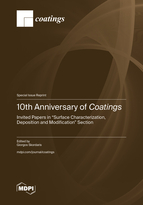10th Anniversary of Coatings: Invited Papers in "Surface Characterization, Deposition and Modification" Section
A special issue of Coatings (ISSN 2079-6412). This special issue belongs to the section "Surface Characterization, Deposition and Modification".
Deadline for manuscript submissions: closed (31 December 2022) | Viewed by 56333
Special Issue Editor
Interests: coatings for cutting tools and machine elements, FEA modelling; superficial treatments; characterization of coated tool's strength, fatigue and adhesion properties
Special Issues, Collections and Topics in MDPI journals
Special Issue Information
Dear Colleagues,
First issued in 2011, Coatings is celebrating its 10th anniversary this year. In this first decade, the journal has managed to attract and publish numerous innovative works related to various domains of disciplines in which the application of coatings gives an added value. Through the devoted work of its Editorial Board, journal staff, and reviewers, our journal Coatings has become a leading publisher in the field.
“Surface Characterization, Deposition and Modification” is one of the biggest sections of Coatings, and was founded in October 2019 by Prof. Dr. Giorgos Skordaris. Since its inception, 308 papers have been published in this section. The scope of Surface Characterization, Deposition and Modification comprises various coating deposition processes and surface treatments as well as microstructural/properties characterization and performance studies of the modified or treated surfaces. Both experimental and theoretical studies are covered. Moreover, the development of novel characterization devices that are specifically designed to evaluate the structural and other properties of modified surfaces are welcome.
This Special Issue is set up to mark the 10th anniversary of Coatings. It is devoted to the rapid publication of scientific papers pertaining to surface and interface engineering for modifying the superficial properties of materials in order to attain protection under demanding contact conditions and/or to improve functional performance. If you would like to be invited to submit an article for review and potential publication in the "10th Anniversary of Coatings: Invited Papers in ‘Surface Characterization, Deposition and Modification’ Section", please send the abstract of your paper to the Guest Editor or reach out to our Editorial Office. Please write “10th Anniversary: Surface Characterization, Deposition and Modification” in the subject line of your email.
Prof. Dr. Giorgos Skordaris
Guest Editor
Manuscript Submission Information
Manuscripts should be submitted online at www.mdpi.com by registering and logging in to this website. Once you are registered, click here to go to the submission form. Manuscripts can be submitted until the deadline. All submissions that pass pre-check are peer-reviewed. Accepted papers will be published continuously in the journal (as soon as accepted) and will be listed together on the special issue website. Research articles, review articles as well as short communications are invited. For planned papers, a title and short abstract (about 100 words) can be sent to the Editorial Office for announcement on this website.
Submitted manuscripts should not have been published previously, nor be under consideration for publication elsewhere (except conference proceedings papers). All manuscripts are thoroughly refereed through a single-blind peer-review process. A guide for authors and other relevant information for submission of manuscripts is available on the Instructions for Authors page. Coatings is an international peer-reviewed open access monthly journal published by MDPI.
Please visit the Instructions for Authors page before submitting a manuscript. The Article Processing Charge (APC) for publication in this open access journal is 2600 CHF (Swiss Francs). Submitted papers should be well formatted and use good English. Authors may use MDPI's English editing service prior to publication or during author revisions.






